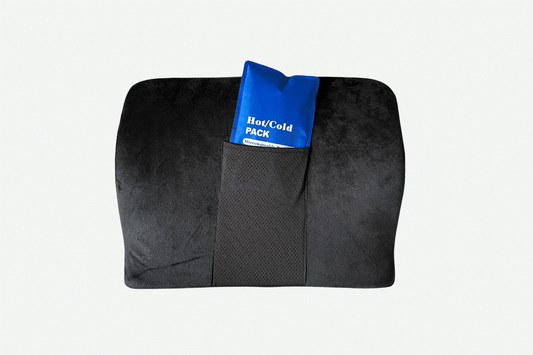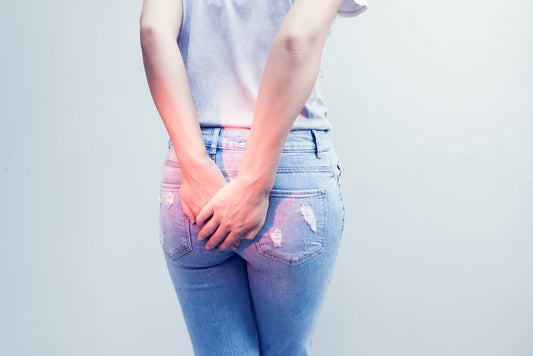How Big Can Hemorrhoids Get?
Robert Cutler, D.O., FAOCPrShare
Everyone has hemorrhoids. Most of the time they lay dormant and go unnoticed. But they can become inflamed, grow in size and then become irritated, causing many of the painful symptoms you’re likely experiencing right now.
Curious about those pea-sized lumps hanging out around your anus? Wondering if you have a comparably big hemorrhoid, if a bulging hemorrhoid will burst, or the question of the hour… how big can hemorrhoids get? Much more on hemorrhoid size can be found below.
How Large Can Hemorrhoids Grow?
Hemorrhoids are classified into four grades determined by size and degree of prolapse. If you can see your prolapsed internal hemorrhoid, you are looking at a grade 2, 3 or 4 hemorrhoid.
- Grade 1 hemorrhoids can be pea or peanut-sized just like their external counterparts, but these hemorrhoids remain as internal bulges and generally do not cause the level of irritation and pain found in those that are prolapsed.
- Grade 2 features similarly enlarged hemorrhoids that spontaneously protrude through the anus during strenuous bowel movements, returning inside the anus on their own.
- Grade 3 hemorrhoids typically remain pea-sized and are again prolapsed, but these hemorrhoids are shallow and must manually be pushed back inside the anus because they will not spontaneously retract.
- Grade 4 is the stage at which hemorrhoids have prolapsed and remain outside the anus, with the potential to take on a purple appearance and grow to the size of a marble or grape. At this point, at-home treatments may not suffice and medical attention is recommended to reduce the affected hemorrhoid.
The grading system applies to internal hemorrhoids that have prolapsed.
External hemorrhoids are from the very start located on the outside of the anus. They are usually much more prone to painful symptoms. One of the most painful kinds of hemorrhoids is what’s known as a thrombosed hemorrhoid. A thrombosed hemorrhoid is a particularly painful external hemorrhoid that occurs when blood clots start to form inside it, causing the hemorrhoid to swell and oftentimes bleed. This swelling is the cause of a hemorrhoid getting bigger.
Symptoms of Enlarged Hemorrhoids
The term enlarged hemorrhoid is simply a synonym for a hemorrhoid that has become a problem. So feel free to use it interchangeably with hemorrhoid if you’re speaking to a doctor, for example. Enlarged hemorrhoids, regardless of the internal or external variety, translate to a few different symptoms:
- In internal hemorrhoids, symptoms generally go unnoticed but can be the source of a small amount of bleeding, typically showing up as drops of bright red blood on your toilet paper or in the toilet. Review the grades in the previous section above for info on enlarged internal hemorrhoids that cause more painful symptoms.
- In external hemorrhoids, symptoms may cause itching, burning, swelling, and pain. Any sort of straining or simply the exertion of passing a stool could lead them to bleed. A large hemorrhoid can also cause hemorrhoid blisters or sores, irritating the sensitive skin in the anal area and making it more susceptible to bleeding.
- In external thrombosed hemorrhoids, the symptoms are notorious for being painful, and the hard lump that forms causes a near-constant ache. As the blood clot inside the hemorrhoid grows it can continue to bleed, with the potential risk of bursting entirely should the pressure become too great.
Do hemorrhoids cause mucus? The inflammation caused by internal hemorrhoids can lead to the excretion of a clear mucus discharge from the anus, another indication that your blood vessels within the rectum have become enlarged.
If you suspect that you have bleeding hemorrhoids, it’s first important to know that rectal bleeding isn’t limited to hemorrhoids. Any consistent or large amount of bleeding, or bleeding accompanied by changes in your bowel habits or stool, signals the need for immediate medical attention to assess the underlying cause.
What Causes Hemorrhoids to Grow?
Hemorrhoids can grow larger from a number of different factors, all of which spell additional pressure placed upon the anal canal. These include:
- Chronic constipation or diarrhea
- Pregnancy or giving birth
- Obesity
- Frequently lifting heavy objects
- Lack of fiber
- Prolonged sitting
Hemorrhoids will also progress, become worse and grow if they are not treated and you continue to exert pressure on them. Treat the symptoms and change your behavior for prevention and to stop growth.
What Are the Risks of Enlarged Hemorrhoids?
As a hemorrhoid increases in size, so too does the severity of symptoms and risk of rupture. Bulging hemorrhoids that are left untreated pose the chance of infection, whether to the swollen vein itself or the weak and damaged tissue and skin of the surrounding area. Untreated hemorrhoids also have a greater likelihood of recurrence.
Treatments for Enlarged Hemorrhoids
The most obvious at-home treatment to reduce the size of hemorrhoids is the use of a vasoconstrictor like Phenylephrine. A vasoconstrictor narrows blood vessels and reduces swelling. Phenylephrine can be found in hemorrhoid creams and ointments, and suppositories. At Doctor Butler’s we prefer the ointment route for its ease of use, and encourage the concurrent use of non-medicated treatments like sitz baths and warm witch hazel compresses to reduce hemorrhoid size.
More advanced medical procedures and surgical options are available should an enlarged hemorrhoid remain unresponsive to at-home methods, and the choice of treatment will ultimately depend on the size of the hemorrhoid and the severity of symptoms. If you aren’t sure how long hemorrhoids can last, it is essential to know at what point you should be seeking medical attention.
Instant Hemorrhoid Relief With Doctor Butler’s
The phrase “small and mighty” may not have been aimed at hemorrhoids, but it seems fitting when discussing those pea-sized foes from below, especially if they begin to grow. While enlarged hemorrhoids can be intimidating, Doctor Butler’s has a full line of proven at-home treatments ready to help you take on the toughest of hemorrhoids, even the ones you can’t see!


